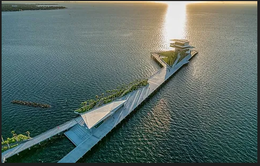CONSERVATION CORNER
A weekly blog for all things conservation
 Durability and Sustainability: Portland Limestone Cement Helps Rebuild New St. Pete Pier Source: https://www.greenercement.com/stpetepier Durability and Sustainability: Portland Limestone Cement Helps Rebuild New St. Pete Pier Source: https://www.greenercement.com/stpetepier Patrick Cullen, BCCD, District Engineer I had pleasure to be able to sit in a statewide meeting for Conservation Engineers where we talked about several topics, one of them being a new type of concrete being seen throughout the state and country. Below are some summarizations of the meeting and the topic itself, as far my knowledge takes me. In the past year there has been a big change in the concrete world here in the US. The concrete has changed from a Portland Cement Formula to a new formula, Portland Limestone Cement Formula (it is called a “green” concrete and “sustainable” concrete.) It has been a long time coming. In Europe and Canada, they have been using this concrete for years. So what changed? While there are charged terms (and skepticism) when you hear “green” concrete being thrown around, this new concrete is not a radical new formula, but an adjustment. The problem lies in a substance the industry calls clinkers. Clinkers are an important ingredient for concrete mixes. In the United States we get many of our clinkers (historically) from coal and coal powered plants, which have been displaced due to Natural Gas, primarily (among other factors). To make the clinker, we take the coal slag and heat it, with limestone and other additives, to a certain temperature when a certain chemical reaction occurs and viola, you have clinker. This process is the most polluting step of the concrete production. (Which is estimated to be responsible for 8% of Global Emissions of CO2. For one single product, this is a significant number).
This new formula has increased the amount of limestone used and decreased the amount of coal slag used and limited the chemical process in duration and energy. We are saving energy and emitting less CO2. Limestone content went from 5% of the mix to 15%....so not drastic, but an improvement. The tests have shown that the specs have changed slightly but the strength is comparable. This type of concrete will also last longer….in a sense (we’ll talk about that next article). It will also give the finished concrete a whiter appearance in final form. Since it is a whiter hue it will reflect more sunlight and won’t be as hot as other concrete during sunny summer days. Concrete holding in heat is a major reason we have “heat islands” in our cities now. This would at least help a small amount. If you are inclined to, you can find more information at www.greenercement.com This website has some case studies of this new product and also a calculator that can estimate how much of a savings in tons of CO2 is saved comparing the old concrete to the new one. The Bradford County Conservation District is committed to helping people manage resources wisely. You can visit the Bradford County Conservation District at 200 Lake Rd in Wysox across from the Wysox Fire Hall. Contact us at (570) 485-3144 or visit our web page at www.bccdpa.com.
0 Comments
Leave a Reply. |
AuthorsVarious staff at the Bradford County Conservation District Archives
July 2024
Categories
All
|
|
Bradford County Conservation District
Stoll Natural Resource Center 200 Lake Road, Suite E | Towanda PA 18848 Phone: (570)-485-3144 |
